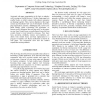Free Online Productivity Tools
i2Speak
i2Symbol
i2OCR
iTex2Img
iWeb2Print
iWeb2Shot
i2Type
iPdf2Split
iPdf2Merge
i2Bopomofo
i2Arabic
i2Style
i2Image
i2PDF
iLatex2Rtf
Sci2ools
ICMCS
2007
IEEE
2007
IEEE
Web Page Segmentation Based on Gestalt Theory
Automatic web page segmentation is the basis to adaptive web browsing on mobile devices. It breaks a large page into smaller blocks, in which contents with coherent semantics are keeping together. Then, various adaptations like single column and thumbnail view can be developed. However, page segmentation remains a challenging task, and its poor result directly yields a frustrating user experience. As human usually understand the web page well, in this paper, we start from Gestalt theory, a psychological theory that can explain human's visual perceptive processes. Four basic laws, proximity, similarity, closure, and simplicity, are drawn from Gestalt theory and then implemented in a program to simulate how human understand the layout of web pages. The experiments show that this method outperforms existing methods.
| Added | 03 Jun 2010 |
| Updated | 03 Jun 2010 |
| Type | Conference |
| Year | 2007 |
| Where | ICMCS |
| Authors | Peifeng Xiang, Xin Yang, Yuanchun Shi |
Comments (0)

